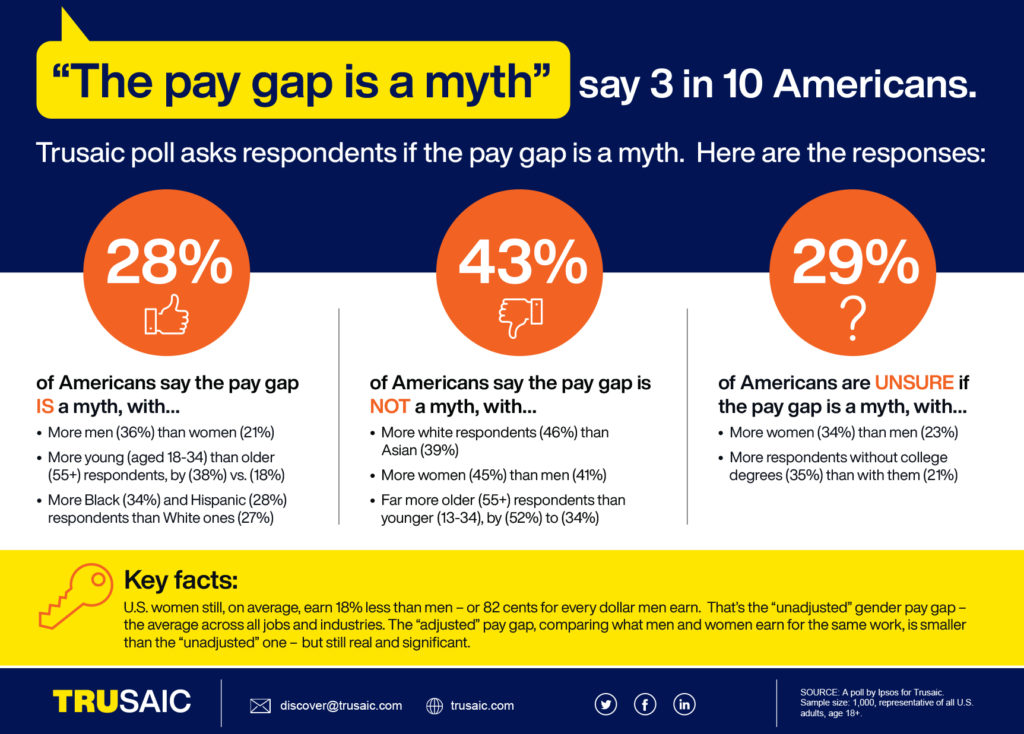By now, it would seem that most people recognize that gender and racial pay gaps exist, right? Wrong.
Trusaic set out to learn how Americans view and understand what’s commonly known as the pay gap and commissioned a poll to mark both Equal Pay Day on March 15 and National Equal Pay Day on April 12; and the weeks between, which comprise an unofficial “Equal Pay Month.”
Market research firm Ipsos asked a nationally representative sample of 1,000 U.S. adults the following question:
“To what extent do you agree or disagree with the following statement? The pay gap is a myth.”
Survey findings
Nearly three in 10 of all respondents (28%) either strongly or somewhat agree that the pay gap is a myth. Another 29% neither agree nor disagree that it’s a myth. Only 43% disagree with the statement; or in other words, accept that the pay gap is a reality.
Far more men (36%) than women (21%) agree, either somewhat or strongly, that the pay gap is a myth, while twice as many men (18%) as women (9%) “strongly agree.”
Below is an infographic to aid in understanding the data captured from the survey:

The pay gap is not a myth
This Equal Pay Day, we’re here to set the story straight. The pay gap is both real and important, but, the thing is, there isn’t just one type. It’s a rather complex issue that, as the data proves, confuses people.
The best-known pay gap is the one between men and women and it’s referred to as the gender pay gap.
This term most commonly refers to the statistic that U.S. women on average earn only 82 cents on every dollar a man earns. This is the “unadjusted” or “uncontrolled” gender pay gap, and it reflects the overall average pay gap for men and women across all jobs and industries.
The “adjusted” or “controlled” gender pay gap, on the other hand, refers to the gap between what men and women earn for performing the same job, after adjusting for or taking into account any potentially legitimate business reasons employers use for paying workers differently, such as job title, work experience, and education, among others.
The adjusted gender pay gap is typically smaller than the unadjusted one.
There is no authoritative, national figure for the adjusted gender pay gap, since “compensable factors” that determine pay vary by employer. The precise adjusted pay gap for any given employer requires conducting a pay equity audit.
Some sources indicate that the percentage figure for the adjusted gender pay gap is somewhere in the low single digits but can be considerably higher in the worst cases.
While adjusted pay gaps may be smaller, the differences in compensation can add up over time. This is because of a concept called the compounding effect, which essentially says that a pay gap over time can result in significantly less compensation throughout one’s career.
A recent American Association of University Women (AAUW) study confirms this. In fact, AAUW’s research found that over the course of a four-decade career, even just a two-cent gap could add up to $80,000 in lost earnings, not including either the lower pensions that women earn as a result or the lost interest if that money had been invested along the way.
It’s important to note that pay gaps also exist at the intersections of multiple dimensions, like gender and race/ethnicity.
So, when you compare, for example, the average earnings of White men and Black women you will see a much larger gap than the one between just men and women. According to recent data aggregated by the American Community Survey, Black women earn just 63 cents on every dollar that a white, non-Hispanic man earns. While this example refers to an unadjusted pay gap, it emphasizes the wage difference when accounting for multiple dimensions.
For those still not convinced the pay gap is real, consider the facts around the starting salaries of today’s professionals.
A recent report by the National Association of College and Employers (NACE) found that the gender pay gap begins right out of college. On average, women earned $52,266 right out of undergraduate school, and men earned $64,022. This gap of roughly 18% mirrors the pay gap data issued by the Bureau of Labor Statistics (BLS).
What’s more is that the NACE report takes into account the fact that men and women may simply choose to pursue less lucrative degrees in college, and as such receive lower-paying jobs right out of college. Even after factoring for those personal choices, a significant wage gap of over 10% between men and women still occurs.
Takeaways for Equal Pay Day
As you can see, the pay gap is a complex topic but it’s a serious one that should clearly not be labeled a myth. And if there’s anything our survey findings prove, it’s that there is a lack of education around pay equity and compensation in general.
On this Equal Pay Day, consider having open conversations around pay with colleagues and coworkers. This openness or pay transparency allows for an environment where pay adjustments and explanations can be candid. It allows for people to understand the legitimate reasons their paid differently and ultimately helps uncover unintentional and intentional pay discrimination. And as a result, it can help close the long-standing pay gaps that we know to be true.









